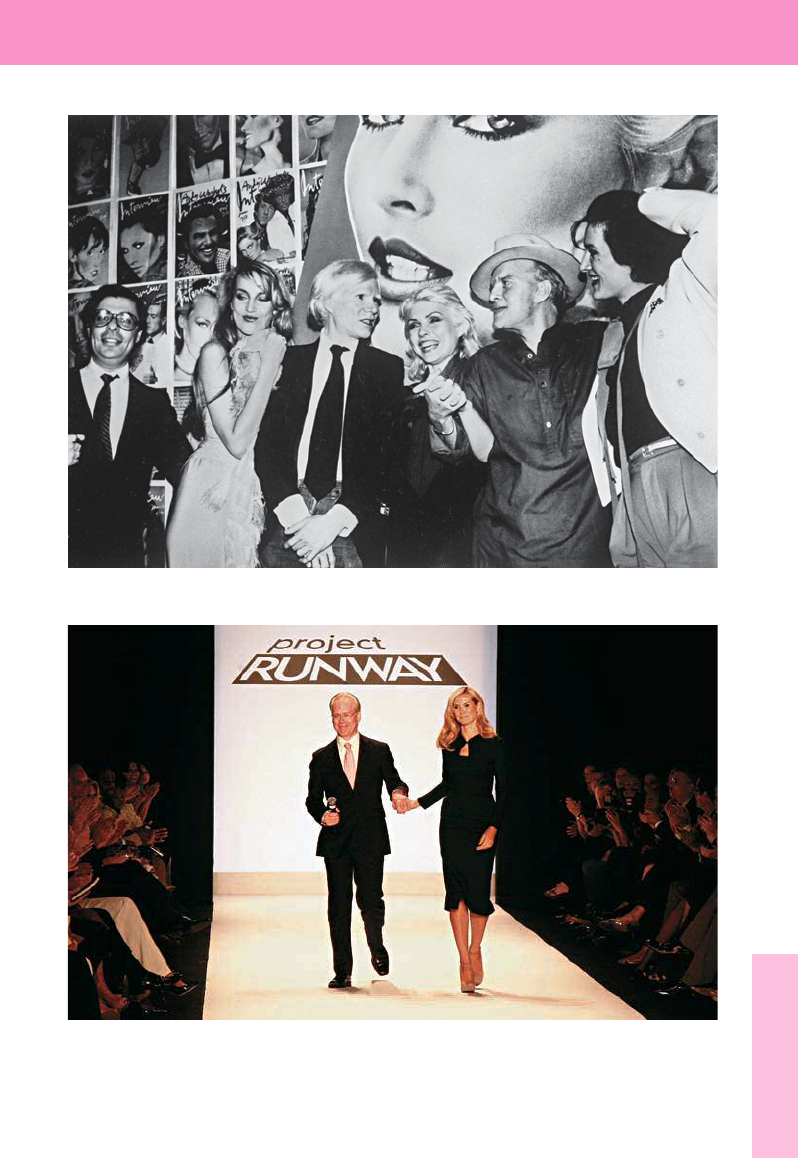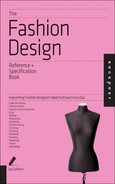
Job:02-30034 Title:RP-Fashion Design Ref and Spec Book
#175 Dtp:225 Page:226
224-233_30034.indd 226 2/27/13 5:19 PM
2 2 6 THE FASHION DESIGN REFERENCE + SPECIFICATION BOOK
(Text)
Chapter 22: Celebrity
Celebrity has always been a part of the fashion mix, at least by association.
Celebrities tend to fall into distinct categories. Royalty, politicians, and other
powerful opinion makers serve as public role models. The subjects of scandal
and rumor engage the public in a love-to-hate relationship. Entertainers and
sports gures allow the public to live vicariously through their roles or their
accomplishments. Looking back at the origins of contemporary fashion, one
nds the couturier Charles Frederick Worth dressing all three: French Empress
Eugénie, famous courtesan Cora Pearl, and actress Sarah Bernhardt. Today
celebrities from other elds often try their hand at fashion design, and fashion
designers become celebrities in their own right—establishing a new standard
for success in the industry.
MODES OF CELEBRITY
Fifteen Minutes
In 1968 Andy Warhol famously declared, “In the future, everyone will be world-famous for
15 minutes.” His prediction has come to pass as society’s seemingly insatiable appetite for
celebrity in any degree, and a general sense of entitlement that demands a moment in the
sun for everyone, intersect with new communication technologies that transmit stories and
images instantly around the globe.
The producers of reality television have capitalized on the willingness of most people to do
just about anything for those fteen minutes. The Peabody Award–winning series Project Run-
way is the fashion industry’s most notable contribution to this phenomenon. From the start,
the value of the whole enterprise was increased by being fronted by celebrity supermodel
Heidi Klum; in the end, it has made a beloved star of mentor Tim Gunn, now chief creative
of cer at Liz Claiborne. For the savvy designer, even making it onto the show can be parlayed
into press clippings or job offers.
The fascination with celebrity stems from the public’s ability to observe, analyze, and critique
a polished parallel world. It is a world fabricated on a sense of intimacy, which the consumer
enters with the ick of a remote control or the scroll of a mouse. The level of intimacy depends
on what any particular celebrity will trigger in a person, be it sexual desire, romantic longing,
or a feeling of security. At best, an adoring public uses the connection as a way to bond with
their peers, let off a little steam, or simply escape into fantasy and be entertained. At its
worst, celebrity worship leads to an unrealistic self-image, issues of esteem, or true obses-
sion. Having even the most basic understanding of the inclination of fans will help designers
decide whether or not they wish to tap into the illusions and promises of celebrity.
Ti
S
Photograph by Charles Eshelman/FilmMagic.
Ed
Tr
Photograph by Robin Platzer/Twin Images/Time Life Pictures/Getty Images.
22
Job:02-30034 Title:RP-Fashion Design Ref and Spec Book
#175 Dtp:225 Page:226
224-233_30034.indd 226 2/27/13 5:19 PM

Job:02-30034 Title:RP-Fashion Design Ref and Spec Book
#175 Dtp:225 Page:227
Book
e:226
224-233_30034.indd 227 2/27/13 5:19 PM
2 2 7
(Text)
s
Tim Gunn and Heidi Klum at the Project Runway Fashion Show,
Spring 2009, Mercedes-Benz Fashion Week
Photograph by Charles Eshelman/FilmMagic.
Editor Bob Colacello, model Jerry Hall, artist/publisher Andy Warhol, singer Debbie Harry, writer
Truman Capote, and jewelry designer Paloma Picasso at a Studio 54 party for Interview magazine
Photograph by Robin Platzer/Twin Images/Time Life Pictures/Getty Images.
22
Job:02-30034 Title:RP-Fashion Design Ref and Spec Book
#175 Dtp:225 Page:227
Book
e:226
224-233_30034.indd 227 2/27/13 5:19 PM

Job:02-30034 Title:RP-Fashion Design Ref and Spec Book
#175 Dtp:225 Page:228
224-233_30034.indd 228 2/27/13 5:19 PM
2 2 8 THE FASHION DESIGN REFERENCE + SPECIFICATION BOOK
(Text)
Front Row and Red Carpet
The designer with the best front row wins, or so it seems at most major fashion runway
presentations—an impression that press coverage does nothing to dispel. Gianni Versace
was one of the rst designers to line his front row with a virtual who’s who of Hollywood and
the music world: Paired with his superstar models and rock-concert energy, they helped make
every runway show spectacular. Of course, the value can ow both ways: securing an invitation
to a high-pro le show improves a guest’s CQ, or celebrity quotient.
Today very few major events forgo the experience of the red carpet photo-op, where the
Hollywood-style set up allows sponsors to position logos behind the parade of guests. The
sight has become so commonplace that its absence at a movie premiere, bene t gala, or
fashion show might suggest that the event is not newsworthy. In this environment, it is no
surprise that designers would vie for the opportunity to dress as many VIP guests as pos-
sible. Some designers go out of their way to offer notable guests the loan of their nest
frocks to display in front of the paparazzi.
C
Fa
s
to
a
of
ce
In
h
T
P
a
o
w
ev
ci
to
th
A
n
S
fa
s
W
A
In
tr
d
fo
p
S
it
w
b
Mary-Kate Olsen and Ashley Olsen at the Chanel Fall/
Winter
2008/2009 Collection, Paris Fashion Week
Photograph by Tony Barson/WireImage.
Actress Sharon Stone wearing Armani on the
red carpet at the
57th Berlin International
Film Festival,
2007
Photograph by Pascal Le Segretain/Getty Images.
22
Job:02-30034 Title:RP-Fashion Design Ref and Spec Book
#175 Dtp:225 Page:228
224-233_30034.indd 228 2/27/13 5:19 PM

Job:02-30034 Title:RP-Fashion Design Ref and Spec Book
#175 Dtp:225 Page:229
Book
e:228
224-233_30034.indd 229 2/27/13 5:19 PM
Celebrity 22 9
(Text)
e
n
Crossover
Fame in one eld seldom translates into great success in another. Many a movie star, televi-
sion personality, sports hero, or popular musician has tried to enter the fashion industry, only
to end up the subject of ridicule, oversaturation, or sale-rack obscurity. Even celebrities with
a passion for fashion and an earnest desire to be involved come face-to-face with the reality
of what it takes to be a fashion designer. There have been some notable exceptions, where
celebrities have worked with designers to develop successful lines in their own name.
In 1985 Jaclyn Smith of Charlie’s Angels fame pioneered the celebrity fashion connection with
her women’s apparel line for Kmart, a collection that continues to perform well in the market.
The small screen also produced one of fashion’s most in uential style makers, Sarah Jessica
Parker of Sex and the City. The company motto of her Bitten line, “Fashion is not a luxury, it’s
a right” sets the tone for a very accessible and affordable collection based on pieces from her
own wardobe. Mary-Kate and Ashley Olsen were able to cross over into the fashion industry
even as child stars, with a teen collection for Wal-Mart. Although the licensing deal was nan-
cially successful, the young actresses did not achieve critical success for their contributions
to the marketplace until they launched The Row and Elizabeth & James, fashion lines in which
they are very involved.
Although rst recognized as a supermodel, activist-entrepeneur Christy Turlington has part-
nered with Puma to produce Nuala, a line of activewear, and Mahanuala, a line of yoga wear.
She is also involved in Sundari, an ayurvedic skincare line. Sports stars have been linked to
fashion design ever since Jean-René Lacoste, “Le Crocodile,” gave his nickname to a tennis
shirt in 1929. Since then the line between active sportswear and fashion has continued to blur.
World-renowned tennis player and Olympic gold medalist Serena Williams designs a line called
Aneres whose focus is fashion rather than sport.
In the eld of music, recording artist Gwen Stefani established a reputation for being a
trendsetter both as the front person for the band No Doubt and in her solo career. She further
demonstrated her fashion acumen as the creator of two successful collections, the fashion-
forward L.A.M.B. and Harajuku Lovers, a line of apparel and accessories designed to incor-
porate the distinctly Japanese aesthetic of kawaii, or cuteness. Rapper and record producer
Sean “Diddy” Combs is responsible for the label Sean John, which has retained the respect of
its urban customer. His collections have also attracted the attention of the fashion industry,
with Combs being nominated for the CFDA Perry Ellis Award for Menswear in his rst year in
business and the CFDA Menswear Designer of the Year in 2004.
e
Photograph by Pascal Le Segretain/Getty Images.
22
Job:02-30034 Title:RP-Fashion Design Ref and Spec Book
#175 Dtp:225 Page:229
Book
e:228
224-233_30034.indd 229 2/27/13 5:19 PM

Job:02-30034 Title:RP-Fashion Design Ref and Spec Book
#175 Dtp:225 Page:230
224-233_30034.indd 230 2/27/13 5:19 PM
2 3 0 THE FASHION DESIGN REFERENCE + SPECIFICATION BOOK
(Text)
Celebrity Proxy
The Swedish clothing company H&M has pioneered the concept of collaborations between
a mainstream retailer and celebrity designers. Although the company has also drawn on the
star power of pop idols like Madonna and Kylie Minogue, their strategy focuses on fashion
designers themselves as celebrities. The clout of the guest designer is matched by the power
of approximately 1,700 stores in thirty-three countries. This model has succeeded in making
high-end designers more accessible through the creation of limited-edition capsule collec-
tions available in select cities. The retailer has created a sense of anticipation about who will
be the next big celebrity designer, thanks to a string of very prominent associations with Karl
Lagerfeld (2004), Stella McCartney (2005), Viktor & Rolf (2006), Roberto Cavalli (2007), Comme
des Garçons (2008), Matthew Willamson (2009) and Jimmy Choo (2009). The bene ts to the
designer and the retailer are obvious, but they are not alone. The press has their celebrity
angle and the public has access to a “designer” label.
Industry Celebrity
Naturally, the industry creates its own celebrities. The Fashion Walk of Fame is New York’s
fashion equivalent of having a star on Hollywood Boulevard. Established in 1999 by the Fash-
ion Center BID, the award honors New York’s most in uential designers, living and deceased,
with plaques embedded in the sidewalk on Seventh Avenue between Thirty- fth and Forty- rst
Streets in Manhattan. Each bronze plaque features an original sketch, the designer’s signa-
ture, and a description of their contributions to the eld. Fashion editors, retailers, historians,
and museum curators make the selections that are then voted on by more than a hundred
industry leaders.
Photograph by Michael Loccisano/FilmMagic.
Sarah Jessica Parker unveiling
her clothing line, Bitten,
2007
Photograph by Peter Kramer/Getty Images.
22
Job:02-30034 Title:RP-Fashion Design Ref and Spec Book
#175 Dtp:225 Page:230
224-233_30034.indd 230 2/27/13 5:19 PM
..................Content has been hidden....................
You can't read the all page of ebook, please click here login for view all page.
